|
The Seventies Bondathon
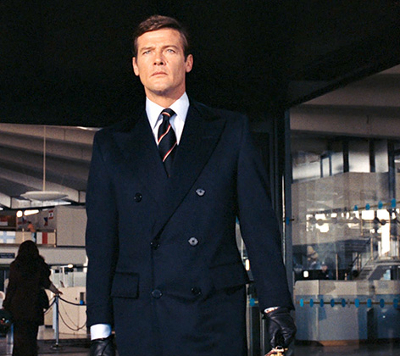
Armed to the gills with
decaffeinated tea, peanuts, and chocolate hobnobs, I blow cobwebs from
my Bond DVDs, engage in a battle of wits with the cat for my favourite
chair, invite Richard O'Sullivan and Anna Karen over, and commence with
the seventies Bondathon. How will these films stack up after some time
away from them?
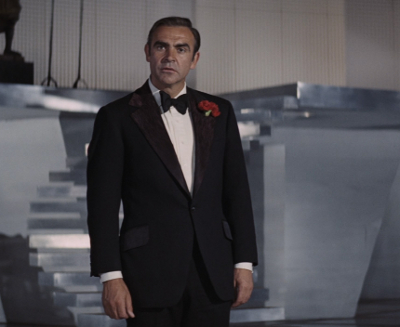
DIAMONDS ARE FOREVER
There is a sizeable shift
in tone towards humour and tongue-in-cheek adventure after the stripped
down (and ultimately tragic) events of On Her Majesty's Secret Service.
While purists lamented this shift to a more campy type of Bond film,
from a commercial point of view it made logical sense and for all its
flaws Diamonds Are Forever is agreeable belly button fluff.
The plot is vague to the
extreme and some of the special effects are strangely subpar for a
James Bond production (the satellite set-piece springs to mind) but the
feeling of aimlessness and diaphaneity that seems to dog Diamonds Are
Forever is brightened by some nice escapism like the oil pipe sequence,
Bond's fight in the lift, the Las Vegas car stunt where the Mustang
comes out of the alleyway the wrong way up - oops!, and the large scale
battle sequence at the end. The wit of Tom Mankiewicz is also a boost.
Connery ambles lazily
through the film eager not to tax himself too much, carrying too much
weight, but when he has one of those deadpan jokes to mutter you
wouldn't want anyone else in his shoes. John Barry's music score is one
of the strangest of his career but it works well with surreal locations
like the desert interludes. The Moon Buggy escape is really good and
seems to be a mischievous wink at those lunar conspiracy theories
suggesting the landings were elaborately staged in a television studio.
This embrace of weirdness helps Diamonds Are Forever get through the
occasional lulls. That circus stuff drags on for too long doesn't it?
Bruce Glover and Putter
Smith as the child-like killers Wint and Kidd also embellish the
sometimes peculiar tone of the film. The casting of Diamonds Are
Forever does appear more haphazard than earlier Bond films. Charles
Gray plays a theatrical, acerbic and very English Blofeld and an
uncharismatic Jill St John is the red-headed female lead Tiffany Case.
Norman Bunton becomes the latest Felix Leiter and is easy to forget.
Series staples Bernard
Lee, Lois Maxwell and dear old Desmond Llewelyn are on hand at least
and Sean Connery is 007 for the final time in an Eon sanctioned film.
Would Diamonds Are Forever have been better if George Lazenby had
returned? It's impossible to say. Lazenby's return would only have made
sense if they'd got Peter Hunt back for a more of a blood relative
follow-up to On Her Majesty's Secret Service. I'm not sure a laid-back
Guy Hamilton romp would have found George in his element.
Arcane trivia: The actor
Michael Gambon said in a television interview that he was asked to test
for the part of James Bond in Diamonds Are Forever by Cubby Broccoli.
When he told the producer he didn't have any of his own hair or teeth,
Broccoli's reply was "Neither does Sean Connery!"
Verdict: Diamonds Are Forever tends to divide but is a lot of fun if you are in the right frame of mind.
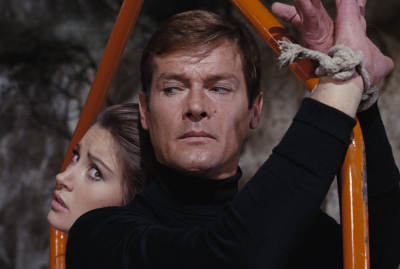
LIVE AND LET DIE
Live and Let Die is a
restart for the series after the studio and producers finally realised
they would have to make do without Sean Connery short of kidnapping him
or holding his family hostage. George Lazenby was chosen because of his
physical similarities to Connery and given the trappings of the
cinematic Bond (tuxedo, casinos, Dom Pérignon etc) but Roger Moore is a
different kettle of fish and it is the series that has to change to
accommodate Moore and not the other way around.
The new 007 is more
lightweight than the actors who came before him but he has a great
sense of humour and cuts a stylish figure. Roger Moore might not be the
most forceful actor ever but in this film he's more believable than
Sean or George as a fashion plate and someone who would know his way
around an outrageously expensive wine list.
It's fascinating to see
the series waveringly grope its way into a new decade and I like Roger
in Live and Let Die. He comes across as a jet-setting playboy who has
been recruited into the secret service and looks much younger and
trimmer than Sean did in Diamonds Are Forever. Live and Let Die has
some jarring shifts in tone and is very much a lucky dip but the boat
chase sequences are exciting and the horror elements (Geoffrey Holder
plays the ghoulish Baron Samedi with some relish) not without charm.
Yaphet Kotto's performance
doesn't drown the audience in subtleness but he's a believable danger
to 007 as is Julius Harris as the metal armed Tee Hee. Clifton James as
Sheriff J.W. Pepper feels like he has wandered in from the set of a
Burt Reynolds film by mistake and David Hedison makes for an excellent
Felix Leiter. Hedison has an obvious ease with his real life friend
Roger Moore. Jane Seymour is beautiful and innocent as Solitaire and
Madeline Smith's small cameo as Miss Caruso at the start is forever
made immortal by Bond's magnetic watch gag.
Bond's ingenuity in
evading the crocs while stranded in the pond is a great moment because
we expect his magnetic watch to get him out of trouble but he has to
rely on his wits instead. Live and Let Die doesn't always work and has
dated in a lot in places but it does give the audience a good time and
'fifth Beatle' George Martin's snappy score serves as a nice
accompaniment to the carnage and fun.
Arcane trivia: Live and
Let Die was suggested as the next adventure by Tom Mankiewicz as the
Blaxploitation films of the time were hip.
Verdict: Despite being all over the shop at times, Live and Let Die is fantastic when it works.
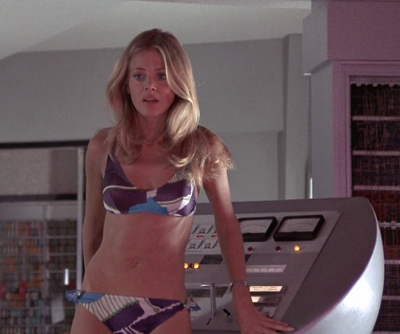
THE MAN WITH THE GOLDEN GUN
The Man with the Golden Gun
continues the uncertain early direction of the Roger Moore era with a
hodge-podge of action, comedy (Clifton James is back as Sheriff J.W.
Pepper - "That English secret agent! From England!") and intrigue that
never completely gels into a satisfying adventure to stand alongside
the best sixties adventures in the James Bond Hall of Fame. The erratic
tone of the film manages to encompass both kung-fu school girls (this
was the age of Bruce Lee mania) and Roger Moore having to belt Maud
Adams around the chops in an ill conceived scene designed to make
Moore's Bond look tougher.
The Swedish Bond girls are a
mixed bag with Maud Adams faring better than Britt Ekland (sorry
Britt). The small scale stakes and feel of the first two Moore films
(which fell by the wayside with The Spy Who Loved Me) are probably the
reason why some fans feel that The Man with the Golden Gun is not the
most exciting of James Bond films. The counter argument - which I am
about to unfurl - would point you in the direction of the
colourful photography and Christopher Lee's effortlessly class
performance as Scaramanga. This is a man who is so refined he'll give
you some dinner before he shoots you!
The spiral car stunt over the
fragments of the ruined bridge is spectacular, there are beautiful and
striking locations in Thailand, and some nice witticisms and lines in
the screenplay by Richard Maibaum and Tom Mankiewicz. Who would want to
shoot 007? M has the booming answer. "Jealous husbands! Outraged chefs!
Humiliated tailors! The list is endless!"
The palpable weirdness that
sometimes infests the first two Roger Moore films is a strength. Here
you have it in spades. A midget bowler hat wearing henchman/villain's
assistant (nicely played by Hervé Villechaize), bizarre locations like
the sunken RMS Queen Elizabeth, the funfair Hall of Mirrors pre-title
sequence, and John Barry's delirious musical score.
I can imagine falling asleep on
Sunday afternoon watching a muddy pan & scan print of this on
television but The Man with the Golden Gun looks good on DVD and comes
alive when you make it more of an event with an evening screening and
some nibbles.
Arcane trivia: Christopher Lee was chosen for the role of Scaramanga after Jack Palance turned the part down.
Verdict: Oh come on, it's not nearly as bad as everyone makes out.
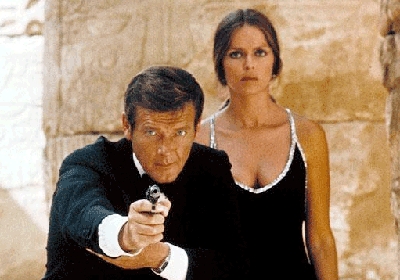
THE SPY WHO LOVED ME
The dystopian futuristic year of
1977. The Sex Pistols are public enemy number one, running wild on
litter blown streets with safety pins through their hooters. Somewhere
in a place you couldn't pinpoint on a map a war is probably raging. The
Queen celebrates a special birthday. The James Bond series becomes more
fantastical.
The Spy Who Loved Me is very
bien dans sa peau. It's not latching onto any passing fads or spending
too much time trying to work out what James Bond's place in the world
might be and I like that. I like the idea of Bond films existing in a
capsule that hasn't been too contaminated by the real world. The
principle aim of The Spy Who Loved Me is to give you a good time and
value for money and if you don't think it does that then you are either
exceptionally hard to please or just don't like Bond films to be too
fantastical, which is fair enough.
Roger Moore is allowed to relax
and play to his strengths and the pre-title ski sequence with THAT
freefall climax really does get you in the Bond mood. The Spy Who Loved
Me always feels like a big event film. The money is up there on the
screen, the locations are varied, the action is huge, the sets look
gigantic. Marvin Hamlisch makes a passable replacement for John Barry
and that extended Lotus Esprit chase is very funky isn't it?
Walter Gotell and Geoffrey Keen
are welcome additions to the supporting cast and Curt Jürgens is uber
dry and sarky as Stromberg. Derek Meddings model work is so much fun
here. The undersea villain lair Atlantis, helicopters, nuclear
submarine swallowing tankers, underwater cars. Barbara Bach is more of
a decorative lead than one who brings anything much to the film through
her acting (which Honor Blackman and Diana Rigg managed to do) but her
game of oneupmanship with 007 through the film is modestly amusing.
Richard Kiel makes his mark as
Jaws and his train scuffle with Bond is always good for a laugh. The
Spy Who Loved Me is a perfect Bond film to watch at Christmas before
the Quality Street are reduced to nothing but orange creams.
Arcane trivia: Jack O'Halloran
(Krypton's vilest mute in Superman II) turned down the part of Jaws. A
young Steven Spielberg was considered at one point to direct The Spy
Who Loved Me.
Verdict: If you are going to make a fantastical Bond film in 1977 this is the way to do it.
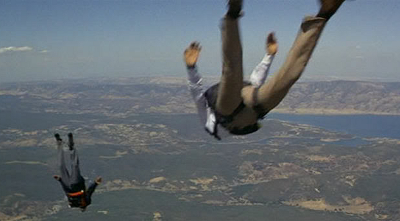
MOONRAKER
By now the films bore scant
resemblance to the plots of the books and were simply using the titles,
character names and a few bits and pieces here and there. It's 1979 and
they are making it up as they go along so that must mean the time is
ripe for Star Wars Bond.
Moonraker has been endlessly
derided and is often held up as as object lesson in how James Bond
films can get out of control if you don't ration the humour. Some
consider it to be the worst Bond film ever made but that's grossly
unfair and lazy. If you removed Blanche Ravalec's Dolly from the story
and edited back some of the action Moonraker has a lot going for it.
Michael Lonsdale is excellent as
Drax and given some great mutterings ("Look after Mr Bond, see that
some harm comes to him..."), Corinne Dufour's death is tense and
frightening, Roger Moore looks genuinely sick and ill when he emerges
from the out of control centrifruge, and Ken Adam's sets are objects of
awe and wonder.
Derek Meddings' special effects
work (all done before computers came along to do everything) is a great
testament to his invention and skill, the freefall PTS is fun, and John
Barry's incredible score is peerless. If you don't take it too
seriously Moonraker is a truly amazing film at times.
Minus points? The film is too
long for its own good and the humour is sometimes too unrestrained. The
Jaws character is demystified here to the point where he loses all of
his menace. The back projection during the boat chase and cable car
sequence is also poor for such an expensive film. A word too about the
product placement, something which most Bond films have to incorporate,
but here, well, it just seems far too intrusive and obvious.
Warts and all, I can accept Moonraker for what it is though and enjoy the experience.
Arcane trivia: Puppetmaster
Gerry Anderson was asked by Harry Saltzman to work on a Moonraker
adaptation in the late sixties. Gerry Anderson's Moonraker, suffice to
say, only exists now in a parallel universe.
Verdict: Just like the Mooooonrakaaaaah....etc
- GH
c 2015
Alternative 007
|

|


